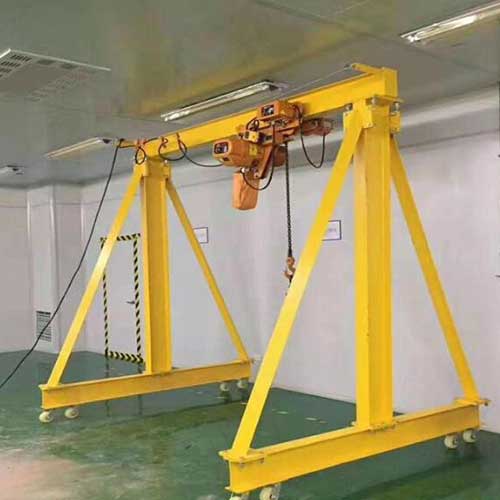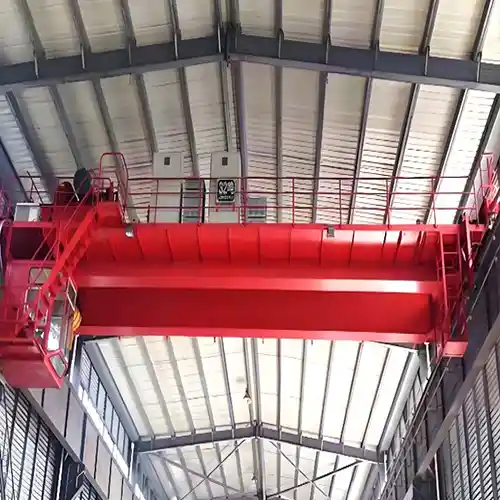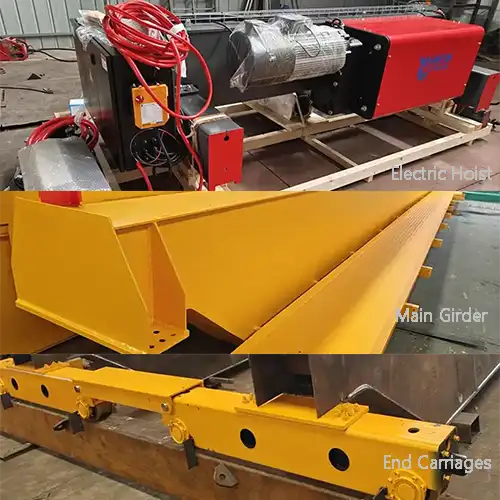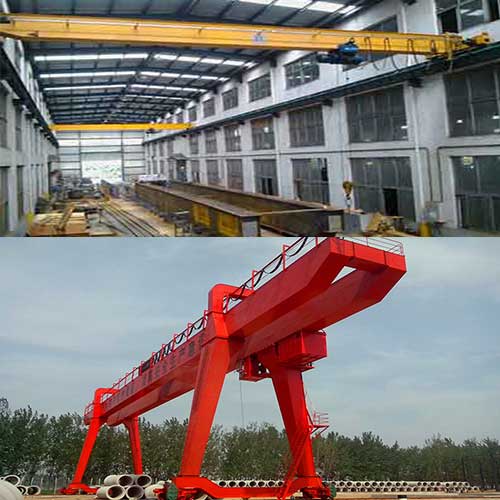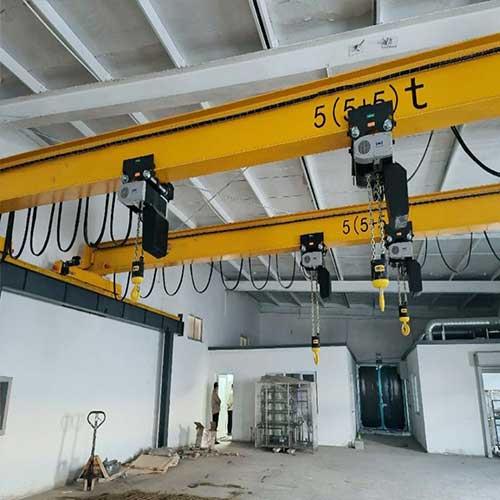Portable Indoor Crane & Mobile Indoor Crane for Sale 0.5 -10 Ton
Portable indoor crane & mobile indoor crane for sale, hot sale 1 ton, 2 ton, 3 ton, 5 ton,10 ton. Custom portable indoor cranes, mobile gantry & jib cranes
| Portable indoor jib crane | 0.25 ton - 2 ton |
| Portable Indoor aluminun crane | 0.25 ton - 5 ton |
| Portable Indoor steel crane | 500kg -10 ton |
| Note | Custom indoor cranes are available. |
Category: Indoor Crane
Your Trusted Indoor Crane Manufacturer & Supplier
Portable Indoor Crane & Mobile Indoor Crane for Sale 0.5 -10 Ton
Your Handy,Small & Most Economical Gantry
Portable indoor crane & mobile indoor crane for sale, hot sale 1 ton, 2 ton, 3 ton, 5 ton,10 ton. Custom portable indoor cranes, mobile gantry & jib cranes
Unlocking Efficiency with Portable Indoor Cranes
In today's fast-paced industrial landscape, the demand for efficient and adaptable material handling solutions has never been greater. One technological innovation that has risen to the occasion is the portable indoor crane. This versatile piece of equipment has revolutionized the way businesses manage their internal logistics, offering a solution that's both flexible and cost-effective. In this article, we'll delve into the world of portable indoor cranes, exploring their definition, importance, and how they seamlessly integrate with indoor crane systems.
Portable indoor cranes, also known as mobile indoor cranes, are precisely what their name suggests – compact and agile lifting devices designed for use within indoor environments. They represent a paradigm shift in material handling, and their importance in various industries cannot be overstated. Their significance extends far beyond a simple keyword, as they provide a transformative solution for companies in need of streamlined operations. Let's briefly introduce some of the relevant keywords that will feature prominently in this article: Portable Indoor Crane, Mobile Indoor Crane, Portable & Mobile Cranes, and Indoor Crane System.
Key Features of Portable Indoor Cranes
Portable indoor cranes are engineered to deliver unmatched flexibility, adaptability, and efficiency within indoor environments. Their key features are the cornerstones of their widespread utility in diverse industries. Let's delve deeper into each of these remarkable attributes.
Portability as a Game-Changer
The foremost feature of portable indoor cranes is their mobility. These cranes come equipped with wheels or casters that allow them to be easily moved within the workspace. This mobility is a game-changer for businesses, as it enables them to respond swiftly to changing operational needs. Here's why portability is such a critical feature:
- Optimized Workspace Layout: Portable indoor cranes can be effortlessly relocated to different areas, allowing for an optimized workspace layout. This means that the crane can be positioned precisely where it is needed for a specific task, saving both time and effort.
- Efficient Material Handling: The ability to move the crane directly to the work area minimizes the need to transport heavy materials manually. This not only reduces the risk of accidents but also significantly enhances the efficiency of material handling processes.
- Adaptability in Crowded Spaces: In industries where space is at a premium, such as manufacturing plants or warehouses, portable indoor cranes shine. They can navigate through tight spaces and narrow aisles, ensuring that no corner of the facility is inaccessible.
Load Capacity Options for Various Applications
Portable indoor cranes come in a variety of load-bearing capacities, making them suitable for a wide range of applications. This diversity in load capacity options ensures that there is a crane available to meet the specific lifting needs of virtually any task. Consider the following benefits:
- Light-Duty to Heavy-Duty Applications: Whether you need to lift delicate components or heavy machinery, there's a portable indoor crane designed to handle the job. Light-duty cranes are ideal for precision work, while heavy-duty models excel at robust lifting tasks.
- Versatility in Industry: Different industries have distinct requirements when it comes to lifting capacity. Portable indoor cranes can accommodate these varying needs, making them valuable tools in manufacturing, warehousing, construction, and maintenance sectors.
- Cost-Effective Solutions: Businesses can invest in portable indoor cranes that precisely match their load-bearing requirements. This ensures cost-effective solutions that do not involve the unnecessary expense of overcapacity.
Versatility Through Adjustable Features
The versatility of portable indoor cranes is one of their standout features, enabling them to adapt to different tasks and work conditions. This adaptability is achieved through a range of adjustable features:
- Boom Extensions: Many portable cranes are equipped with adjustable boom extensions that can be extended or retracted as needed. This feature allows operators to reach different heights and positions, making them suitable for a wide array of lifting scenarios.
- Height Settings: Portable indoor cranes often offer adjustable height settings, allowing them to accommodate various workspace configurations and load requirements. This flexibility ensures that the crane can work efficiently in spaces with different ceiling heights.
- Accessories and Attachments: To further enhance their adaptability, these cranes can be equipped with a variety of attachments such as hooks, slings, and specialized lifting equipment. These accessories enable the crane to perform a broad spectrum of tasks.
User-Friendly Controls for Ease of Operation
Modern portable indoor cranes are designed with user-friendly controls, ensuring that both experienced crane operators and those with minimal training can operate them with confidence. The ease of operation contributes to efficiency and safety in the workplace. Some key elements of user-friendly controls include:
- Intuitive Joystick and Buttons: Portable indoor cranes often feature an intuitive joystick or button-based control system that allows for precise movements and positioning. Operators can quickly grasp the controls, reducing the learning curve.
- Safety Features: User-friendly controls are complemented by safety features such as emergency stop buttons, overload protection, and audible alarms. These safety mechanisms ensure the well-being of operators and personnel working in the vicinity of the crane.
- Remote Control Options: Some portable indoor cranes come with remote control capabilities, allowing operators to control the crane from a safe distance. This feature enhances safety in situations where close proximity to the crane may not be ideal.
The user-friendly controls are integral to the seamless integration of portable indoor cranes into various industrial processes. They offer precise control and reduce the margin of error, resulting in smoother and safer operations.
Portable Indoor Gantry Crane / Portable Indoor Overhead Cranes:
Portable indoor gantry cranes and overhead cranes are versatile indoor lifting devices designed to facilitate material handling. While they share the common goal of moving heavy loads, their structures differ significantly. Gantry cranes are characterized by a horizontal beam supported by two vertical legs equipped with wheels, offering mobility for horizontal load movement. In contrast, overhead cranes are suspended from the ceiling via a system of tracks, enabling efficient vertical load movement along predetermined pathways.
Features and Advantages:
Gantry cranes stand out for their adaptability, making them well-suited for tasks in confined indoor spaces. Their mobility allows for the flexible positioning of loads at various points within a facility, making them ideal for applications that require horizontal movement and versatility. Overhead cranes, conversely, excel in maximizing floor space usage, particularly in warehouses and manufacturing plants. Since they do not obstruct the ground, overhead cranes are perfect for vertical lifting in environments where floor space optimization is a priority. Both crane types offer distinct advantages, with gantry cranes focusing on adaptability, and overhead cranes prioritizing space efficiency.
Applications and Typical Case:
Gantry cranes find widespread use in manufacturing facilities for tasks such as assembly, maintenance, and material handling. Additionally, they prove valuable in warehouses for efficient inventory management and the movement of heavy goods, where quick, adaptable load handling is essential. Overhead cranes are particularly well-suited for manufacturing facilities where floor space optimization is a key concern. These cranes are highly effective in environments with limited ground-level maneuverability and are favored in setups with predefined pathways for load movement. A typical case might involve a manufacturing plant employing an adjustable height portable indoor gantry crane for flexible heavy equipment positioning during assembly, providing both stability and versatility in load handling.
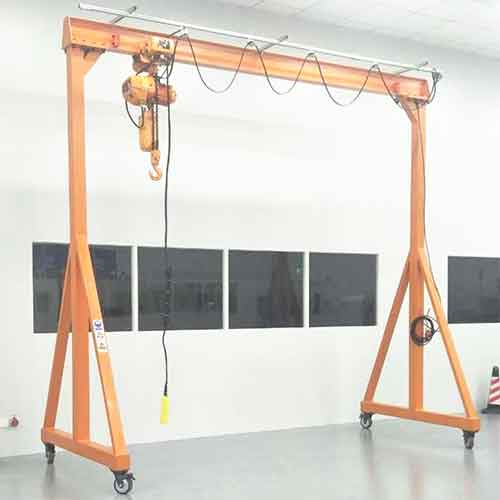
Fixed Height Portable Indoor Gantry Crane:
Crane Overview:
Fixed height gantry cranes have a stationary horizontal beam, which means that the lifting height remains constant.
Features:
- Simplified design with a fixed lifting height.
- Suitable for consistent load requirements.
Advantages:
- Robust and cost-effective solution for repetitive tasks.
- Minimal maintenance and uncomplicated operation.
Applications:
- Loading and unloading goods with a standard height requirement.
- Stationary tasks in manufacturing or maintenance.
Typical Case:
A factory uses a fixed height portable indoor gantry crane to consistently move heavy materials from one area to another on the same level, ensuring a stable and reliable lifting solution.
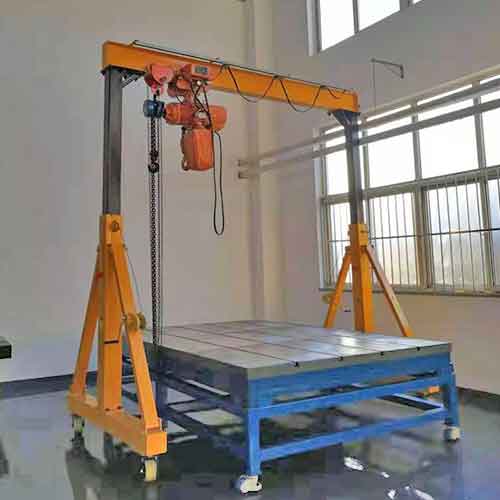
Adjustable Height Portable Indoor Gantry Cranes:
Crane Overview:
Adjustable height gantry cranes are equipped with a telescoping beam, allowing operators to change the lifting height as needed.
Features:
- Telescopic beam for flexible lifting heights.
- Well-suited for versatile applications with varying load sizes.
Advantages:
- Accommodates changing needs by adjusting the lifting height.
- Versatility in applications with varying load requirements.
Applications:
- Manufacturing environments with fluctuating load sizes.
- Warehouses with diverse storage and material handling demands.
Typical Case:
A fabrication workshop employs an adjustable height portable indoor gantry crane to handle various loads of different sizes, adapting to the specific height required for each task.
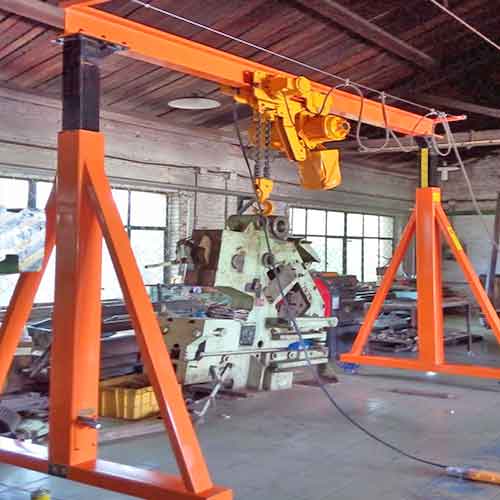
Steel Portable Indoor Crane:
Crane Overview:
Steel portable indoor cranes are known for their durability and strength. They are ideal for heavy-duty applications.
Features:
- Steel construction for high load-bearing capacity.
- Resistant to wear and tear.
Advantages:
- Suitable for lifting extremely heavy loads.
- Long-lasting and robust, making them ideal for demanding industrial tasks.
Applications:
- Steel mills for moving large metal sheets.
- Manufacturing plants for handling heavy machinery.
Typical Case:
A steel fabrication facility employs a steel portable indoor crane to lift and transport steel beams, offering the required strength and durability to handle such heavy materials.
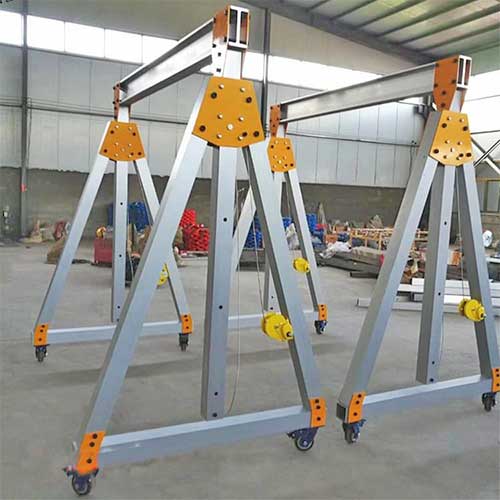
Aluminum Portable Indoor Crane:
Crane Overview:
Aluminum cranes are lightweight and corrosion-resistant, making them ideal for applications where weight restrictions or corrosion avoidance are concerns.
Features:
- Lightweight and easy to maneuver.
- Resistant to rust and corrosion.
Advantages:
- Ideal for environments where avoiding rust or corrosion is critical.
- Suitable for locations where weight restrictions are in place, such as mezzanines.
Applications:
- Cleanroom environments where avoiding contamination is essential.
- Food processing facilities to ensure the safety and cleanliness of operations.
Typical Case:
A pharmaceutical company uses an aluminum portable indoor crane in its cleanroom to handle sensitive equipment without the risk of contamination or corrosion.
Portable Indoor Jib Cranes:
Portable indoor jib cranes are compact and efficient lifting devices designed for indoor material handling. They are characterized by a vertical post or pillar mounted to a base, which supports a horizontal boom. The key feature of these cranes is their ability to rotate 360 degrees, allowing for precise load positioning within a given radius.
Features:
- 360-degree rotation: The horizontal boom of portable indoor jib cranes can be rotated fully, offering optimal flexibility in load placement.
- Variations: Portable indoor jib cranes come in different variations, including wall-mounted, freestanding, and articulating models. Wall-mounted cranes are anchored to a wall or column, freestanding cranes are not attached to any support structure, and articulating cranes have a moveable arm for extended reach.
Advantages:
Portable indoor jib cranes provide quick and precise material handling within a confined workspace. Their compact design allows for placement in tight spaces, making them ideal for environments with limited floor space. The 360-degree rotation enables efficient load placement, ensuring tasks are completed with precision.
Applications:
These cranes are commonly used at manufacturing workstations, where precise assembly tasks demand efficient load handling and placement. Smaller workshops and maintenance facilities also benefit from the compact design and maneuverability of portable indoor jib cranes, as they streamline the lifting of heavy parts and equipment.
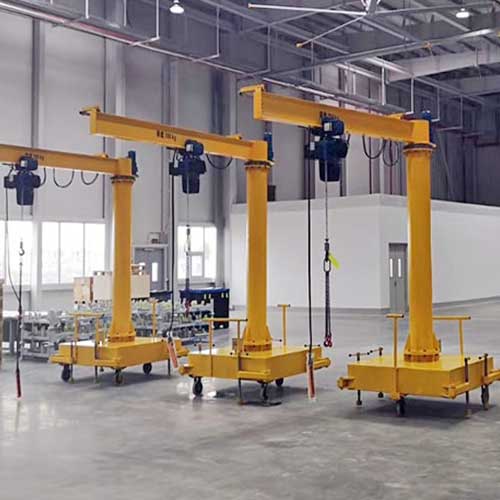
Free-standing Portable Indoor Jib Cranes:
- Crane Type: Free-standing portable indoor jib cranes are self-supporting, meaning they are not anchored to walls or columns.
- Structure: They consist of a vertical post or pillar mounted on a base, from which a horizontal boom extends.
- Rotation: These cranes have a 360-degree rotation capability, providing optimal load placement flexibility.
- Advantages:
- Suitable for locations where wall or column mounting is not possible or convenient.
- Freestanding design allows for placement anywhere in the workspace without requiring additional support.
- Compact design and 360-degree rotation facilitate efficient load handling and precise positioning.
- Applications:
- Commonly used in manufacturing workstations and workshops for versatile material handling and assembly tasks.
- Ideal for facilities where wall or column attachment may not be practical or is restricted.
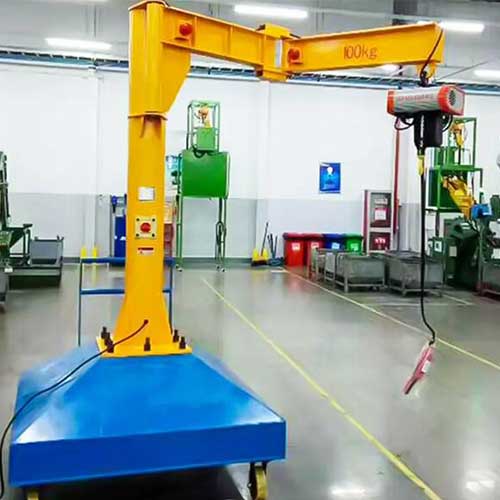
Articulating Portable Indoor Jib Cranes:
- Crane Type: Articulating portable indoor jib cranes are designed with a moveable arm, allowing for extended reach and versatile load positioning.
- Structure: They feature a vertical post or pillar mounted on a base, similar to traditional jib cranes, but with the added feature of an articulating arm.
- Rotation: Like other jib cranes, they offer 360-degree rotation for optimal load placement within a specified radius.
- Advantages:
- The articulating arm allows for extended reach, making them suitable for tasks that require precise positioning at varying distances.
- Compact and maneuverable design ensures easy placement in confined workspaces.
- 360-degree rotation enables efficient load handling with precision.
- Applications:
- Valuable for tasks that demand both precise positioning and extended reach, such as assembly work and maintenance.
- Ideal for environments where space optimization is crucial, given their compact and maneuverable nature.
These two types of portable indoor jib cranes offer unique advantages, with free-standing jib cranes providing flexibility in placement and articulating jib cranes offering extended reach for tasks that require both precision and versatility.
Benefits of Portable Indoor Cranes
Portable indoor cranes bring a host of advantages to the table, making them invaluable tools for various industries. These benefits significantly impact the efficiency, safety, and overall productivity of material handling tasks. Let's delve into the key advantages:
Flexibility for a Wide Range of Tasks
One of the standout benefits of portable indoor cranes is their versatility. These cranes are well-suited for an array of lifting tasks, from precision work to heavy-duty applications. Their adaptability is a game-changer for businesses, as they can seamlessly switch between different jobs within the same facility. This flexibility translates to time and resource savings.
Cost-Effectiveness Compared to Fixed Crane Systems
Portable indoor cranes are cost-effective solutions, particularly when compared to the installation of fixed crane systems. Installing a fixed crane can be a time-consuming and expensive endeavor. In contrast, portable indoor cranes are ready for use right out of the box, eliminating the need for construction or infrastructure modifications. This cost-efficiency is particularly appealing for small and medium-sized enterprises looking to optimize their material handling processes without breaking the bank.
Space Optimization and Floor Space Savings
In environments where floor space is at a premium, portable indoor cranes shine. Their compact design and ability to navigate through tight spaces and narrow aisles ensure that no corner of the facility goes underutilized. These cranes maximize the available space, allowing businesses to make the most of their indoor areas. Space optimization is especially crucial in crowded manufacturing plants and warehouses, where every inch counts.
Enhanced Productivity and Reduced Downtime
Portable indoor cranes contribute to enhanced productivity by simplifying and expediting material handling tasks. Their user-friendly controls and precision in load positioning reduce the margin of error and minimize downtime due to delays or accidents. The ability to swiftly adapt to changing operational needs ensures that tasks are completed efficiently, leading to improved overall productivity and a safer working environment.
In the subsequent sections of this article, we will explore the diverse applications of portable indoor cranes across various industries, underscoring how these cranes are instrumental in streamlining operations and delivering tangible benefits to businesses.
Applications of Portable Indoor Cranes
Portable indoor cranes are versatile and find applications in various industries, enhancing efficiency and safety in a multitude of material handling tasks. Here are the primary applications where these cranes are essential:
Manufacturing: Assembly, Loading, Unloading, and Maintenance
Portable indoor cranes are integral in manufacturing processes. They excel in assembly tasks, aiding in the precise placement of components and equipment. Whether it's the automotive, electronics, or any manufacturing sector, these cranes streamline assembly tasks, reducing manual labor and improving product quality. Moreover, they play a vital role in loading and unloading materials, ensuring a smooth material flow within the production line. Additionally, their adaptability makes them valuable in equipment maintenance, facilitating the repair and upkeep of machinery and tools.
In manufacturing, several types of portable indoor cranes are commonly used to address specific material handling needs. Here are some of the key types, along with their features, benefits, typical applications, and tonnage capacities:
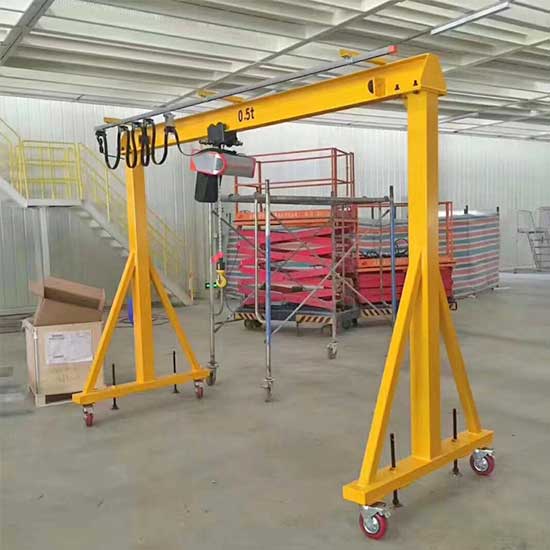
Portable Indoor Gantry Cranes:
Features:
- Horizontal beam supported by two vertical legs with wheels for mobility.
- Trolley system for precise load handling.
- Available in both fixed and adjustable height configurations.
- Durable steel or lightweight aluminum construction options.
Benefits:
- Versatile for various manufacturing tasks, including assembly, loading/unloading, and maintenance.
- Ideal for confined spaces due to their mobility and compact design.
- Cost-effective compared to fixed crane systems.
- Quick and easy setup without the need for infrastructure modifications.
Typical Applications:
- Assembly lines for precise positioning of components.
- Loading and unloading of materials on production floors.
- Maintenance tasks involving heavy machinery.
Tonnage Capacities:
- Vary widely, from 1 ton to 10 tons or more, depending on the specific crane model.
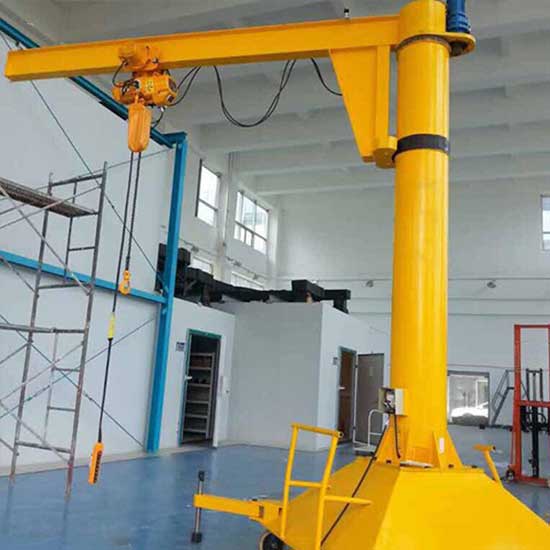
Portable Indoor Jib Cranes:
Features:
- Vertical post or pillar mounted to a base with a horizontal boom that rotates 360 degrees.
- Variations include wall-mounted, freestanding, and articulating models.
Benefits:
- Quick and precise load handling and placement within a confined area.
- Compact design and maneuverability for placement in tight spaces.
- 360-degree rotation for efficient load positioning.
Typical Applications:
- Manufacturing workstations for precise assembly tasks.
- Small workshops and maintenance facilities.
Tonnage Capacities:
- Typically range from 0.25 tons to 5 tons, although heavier-duty models are available.
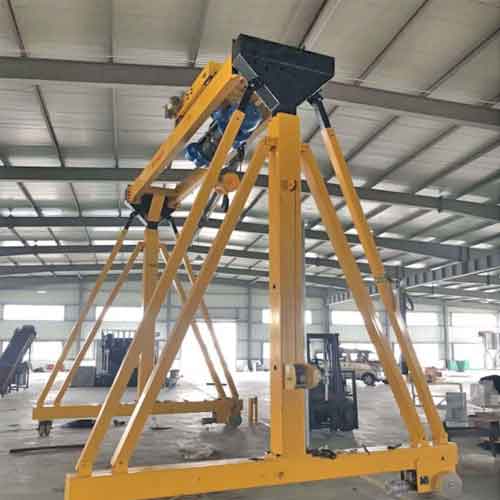
Portable Overhead Gantry Cranes:
Features:
- Ceiling-suspended crane with a trolley system.
- I-beam or enclosed track design for smooth load movement.
Benefits:
- Efficient use of overhead space, maximizing floor space for manufacturing.
- Ideal for repetitive and high-frequency lifting tasks.
- Great for precision work due to smooth load movement.
Typical Applications:
- High-speed assembly lines with frequent load handling.
- Processes involving heavy components that require precision.
Tonnage Capacities:
- Can range from 1 ton to 15 tons or more, depending on the specific model.

Adjustable Height Gantry Cranes:
Features:
- Telescoping beam for flexible lifting heights.
- Durable and adaptable to varying load sizes.
Benefits:
- Accommodates changing lifting height requirements.
- Suitable for versatile applications with varying load sizes.
- Enhanced adaptability in manufacturing environments.
Typical Applications:
- Manufacturing facilities with fluctuating load sizes.
- Warehouses with diverse storage and material handling demands.
Tonnage Capacities:
- Typically range from 1 ton to 5 tons or more, depending on the specific crane model.
In manufacturing, the choice of portable indoor crane depends on specific tasks, available space, and load requirements. The features and benefits of each type of crane enable manufacturers to optimize their material handling processes, resulting in increased productivity, improved safety, and cost-effective operations. Tonnage capacities can vary significantly, allowing manufacturers to select the appropriate crane based on the weight of the materials they need to handle.
Warehousing: Material Handling and Inventory Management
Warehouses rely on efficient material handling to manage inventory effectively. Portable indoor cranes prove indispensable in this regard. They expedite the loading and unloading of pallets, crates, and heavy items, leading to quicker order fulfillment and efficient stock replenishment. By optimizing storage and retrieval processes, these cranes help warehouses maintain organized and space-efficient inventory systems.
Warehousing operations also rely on various types of portable indoor cranes to streamline material handling processes. Here are the key types of portable indoor cranes used in warehousing, along with their features, benefits, typical applications, and tonnage capacities:
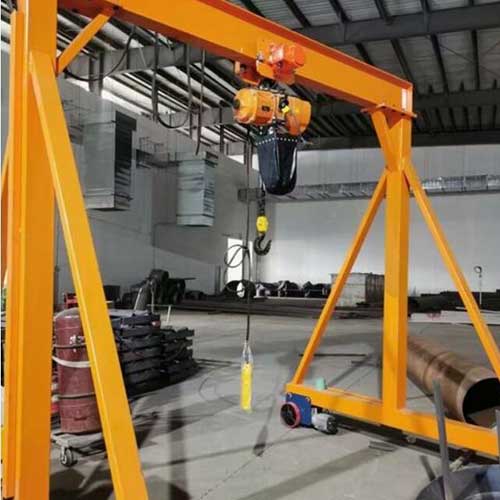
1. Portable Indoor Gantry Cranes:
Features:
- Horizontal beam supported by two vertical legs with wheels for mobility.
- Trolley system for precise load handling.
- Available in both fixed and adjustable height configurations.
- Durable steel or lightweight aluminum construction options.
Benefits:
- Versatile for various warehousing tasks, including loading/unloading and inventory management.
- Mobility allows for easy positioning in different areas of the warehouse.
- Maximizes floor space for efficient storage and material handling.
- Cost-effective compared to fixed crane systems.
Typical Applications:
- Loading and unloading of palletized goods.
- Efficient inventory management within the warehouse.
Tonnage Capacities:
- Can range from 1 ton to 10 tons or more, depending on the specific crane model.
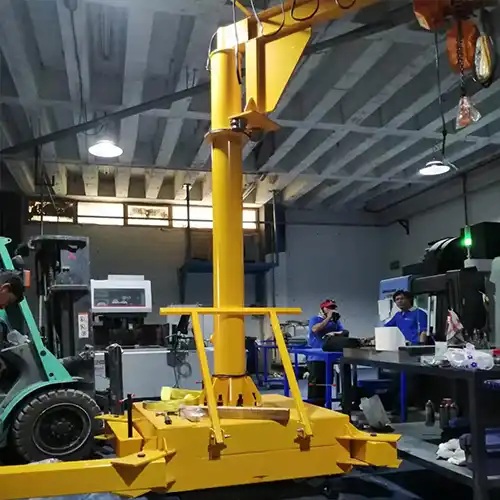
2. Portable Indoor Jib Cranes:
Features:
- Vertical post or pillar mounted to a base with a horizontal boom that rotates 360 degrees.
- Variations include wall-mounted, freestanding, and articulating models.
Benefits:
- Quick and precise load handling and placement within the confined space of a warehouse.
- Compact design and maneuverability for use in narrow aisles and tight storage areas.
- 360-degree rotation for efficient load positioning.
Typical Applications:
- Efficient material handling within narrow aisles and tight spaces.
- Loading and unloading of goods from storage racks.
Tonnage Capacities:
- Typically range from 0.25 tons to 5 tons, although heavier-duty models are available.
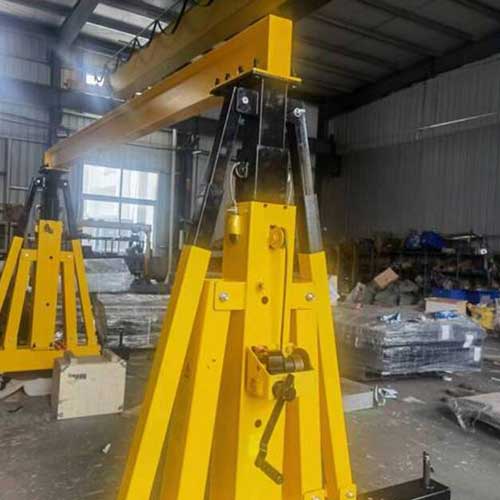
4. Adjustable Height Gantry Cranes:
Features:
- Telescoping beam for flexible lifting heights.
- Durable and adaptable to varying load sizes.
Benefits:
- Accommodates changing lifting height requirements, allowing for versatile use in warehousing.
- Ideal for storage of varying-sized loads and efficient inventory management.
- Enhanced adaptability to meet evolving material handling demands.
Typical Applications:
- Warehouses with dynamic storage requirements for different-sized goods.
- Efficient loading and unloading of materials with varying heights.
Tonnage Capacities:
- Typically range from 1 ton to 5 tons or more, depending on the specific crane model.
In warehousing, the choice of portable indoor crane depends on the specific tasks, available space, and load requirements. The features and benefits of each type of crane help warehouses optimize their material handling operations, leading to increased productivity, enhanced safety, and cost-effective inventory management. Tonnage capacities vary, allowing warehouses to select the appropriate crane based on the weight of the materials they need to handle.
Construction: Lifting and Placing Heavy Construction Materials
The construction industry heavily relies on portable indoor cranes for lifting and positioning heavy construction materials. Whether it's hoisting steel beams, placing precast concrete elements, or aiding in the erection of structural components, these cranes provide the necessary versatility and load-bearing capacity. Their mobility allows for efficient movement to various areas on construction sites, streamlining construction tasks with precision and safety.
Construction sites require efficient and versatile material handling solutions to move heavy materials and equipment. Portable indoor cranes play a vital role in these environments. Here are the types of portable indoor cranes commonly used in construction, along with their features, benefits, typical applications, and tonnage capacities:
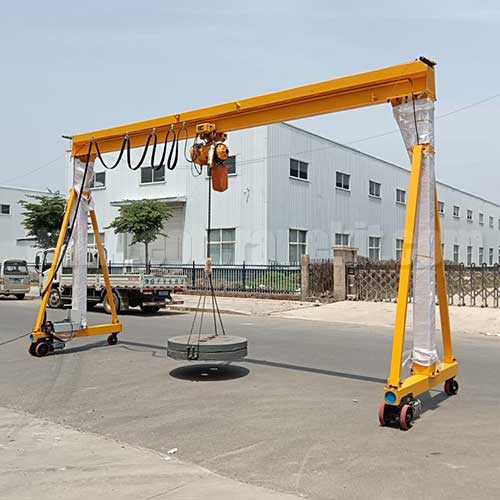
Portable Indoor Gantry Cranes 2000kg for subway construction
Features:
- Horizontal beam supported by two vertical legs with wheels for mobility.
- Trolley system for precise load handling.
- Available in both fixed and adjustable height configurations.
- Durable steel or lightweight aluminum construction options.
Benefits:
- Versatile for various construction tasks, including lifting and positioning of heavy construction materials.
- Mobility allows for easy relocation within construction sites.
- Cost-effective and quick setup, avoiding the need for extensive construction or infrastructure modifications.
Typical Applications:
- Hoisting and positioning of steel beams and structural components.
- Erection of precast concrete elements.
- Handling and transportation of heavy construction materials.
Tonnage Capacities: - Can range from 1 ton to 10 tons or more, depending on the specific crane model.

Portable Overhead Cranes:
Features:
- Ceiling-suspended crane with a trolley system.
- I-beam or enclosed track design for smooth load movement.
Benefits:
- Efficient use of overhead space in construction sites, optimizing ground space.
- Ideal for high-frequency lifting tasks with precision and control.
- Smooth load movement for accurate positioning of materials and equipment.
Typical Applications:
- Hoisting and positioning of heavy construction materials.
- Precise placement of structural components during construction.
Tonnage Capacities: - Can range from 1 ton to 15 tons or more, depending on the specific model.

Adjustable Height Gantry Cranes:
Features:
- Telescoping beam for flexible lifting heights.
- Durable and adaptable to varying load sizes.
Benefits:
- Accommodates changing lifting height requirements, making it versatile for different construction tasks.
- Ideal for projects with varying-sized loads and the need for efficient material handling.
- Enhanced adaptability to meet evolving construction requirements.
Typical Applications:
- Construction sites with dynamic height requirements for lifting.
- Lifting and positioning of heavy construction materials and equipment.
Tonnage Capacities: - Typically range from 1 ton to 5 tons or more, depending on the specific crane model.
In construction, the choice of portable indoor crane depends on the specific tasks, site conditions, and load requirements. The features and benefits of each type of crane help construction sites streamline their material handling processes, leading to increased productivity, enhanced safety, and cost-effective operations. Tonnage capacities can vary significantly, allowing construction sites to select the appropriate crane based on the weight of the materials and equipment they need to handle.
Maintenance: Equipment Repair within Industrial Facilities
Regular maintenance and repair of machinery and equipment are critical in industrial facilities. Portable indoor cranes play a crucial role in these maintenance tasks by safely lifting, transporting, and positioning heavy components for servicing or replacement. This not only streamlines the maintenance process but also enhances workplace safety by reducing manual lifting and handling, which can be physically demanding and risky.
Maintenance tasks within industrial facilities often require precise and efficient material handling solutions. Portable indoor cranes serve this purpose effectively. Here are the types of portable indoor cranes commonly used in maintenance, along with their features, benefits, typical applications, and tonnage capacities:
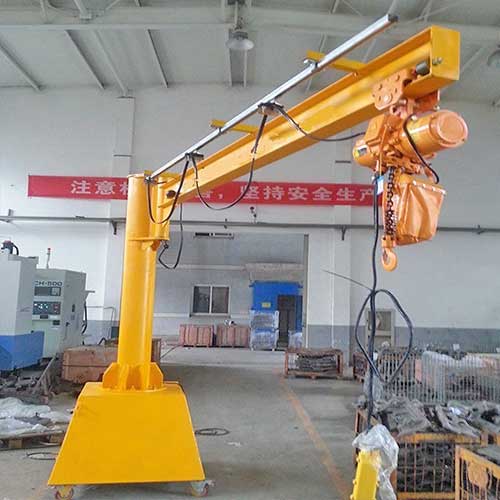
Portable Indoor Jib Cranes:
Features:
- Vertical post or pillar mounted to a base with a horizontal boom that rotates 360 degrees.
- Variations include wall-mounted, freestanding, and articulating models.
Benefits:
- Quick and precise load handling and placement for maintenance tasks.
- Compact design and maneuverability for use in tight spaces within industrial facilities.
- 360-degree rotation for efficient load positioning.
Typical Applications:
- Equipment repair and maintenance within industrial facilities.
- Precise handling and placement of components during servicing.
Tonnage Capacities: - Typically range from 0.25 tons to 5 tons, although heavier-duty models are available.

Portable Overhead Cranes:
Features:
- Ceiling-suspended crane with a trolley system.
- I-beam or enclosed track design for smooth load movement.
Benefits:
- Efficient use of overhead space, allowing for precise load positioning during maintenance.
- Ideal for tasks that require frequent and controlled lifting of heavy components.
- Smooth load movement for accuracy during maintenance procedures.
Typical Applications:
- Equipment repair and maintenance in facilities with high ceilings.
- Handling and positioning of heavy machinery during servicing.
Tonnage Capacities: - Can range from 1 ton to 15 tons or more, depending on the specific model.

Adjustable Height Gantry Cranes:
Features:
- Telescoping beam for flexible lifting heights.
- Durable and adaptable to varying load sizes.
Benefits:
- Accommodates changing lifting height requirements during maintenance.
- Versatile for maintenance tasks involving varying-sized components and equipment.
- Enhanced adaptability to meet evolving maintenance demands.
Typical Applications:
- Facilities with maintenance tasks that require changing height requirements.
- Lifting and positioning of equipment and machinery during servicing.
Tonnage Capacities: - Typically range from 1 ton to 5 tons or more, depending on the specific crane model.
In maintenance operations, the choice of portable indoor crane depends on the specific tasks, space constraints, and load requirements. The features and benefits of each type of crane enable maintenance teams to carry out their tasks efficiently, leading to increased productivity, improved safety, and cost-effective maintenance processes. Tonnage capacities vary, allowing maintenance teams to select the appropriate crane based on the weight of the components and equipment they need to handle.
In each of these applications, portable indoor cranes offer a cost-effective and efficient solution to material handling needs. They contribute to increased productivity and safety while minimizing downtime and labor-intensive processes, making them indispensable tools across various industries.
Indoor Crane Systems
Indoor crane systems are comprehensive material handling solutions designed for a wide range of industrial applications within enclosed spaces. These systems are integral to modern industrial operations, contributing significantly to efficiency, safety, and productivity. The core components of an indoor crane system include the crane itself, support structures, and often, rails or tracks.
Integration of Portable Indoor Cranes with Rails and Components:
Indoor crane systems often utilize a combination of fixed and portable cranes, integrated with rails, tracks, and various components to facilitate seamless material handling. Here's how the integration enhances operational efficiency:
- Rails and Tracks: Overhead and ground-level rails or tracks are installed within the facility to define pathways for crane movement. These rails provide a guided route for portable cranes, ensuring controlled and precise load transportation.
- Components: Indoor crane systems may include components like lifters, hooks, and hoists, which can be attached to the crane for specialized tasks. These components are chosen based on the specific material handling needs of the facility.
- Crane Types: The integration of various types of portable indoor cranes, such as gantry cranes, jib cranes, and overhead cranes, offers flexibility. For example, portable gantry cranes can be used on ground-level rails for tasks like loading and unloading, while overhead cranes on ceiling-mounted tracks are employed for precise, high-level lifting.
- Enhancing Safety and Efficiency in Operations:
- Indoor crane systems play a crucial role in improving safety and operational efficiency:
- Enhanced Precision: Rails and tracks ensure that loads are precisely positioned, reducing the risk of accidents or damage during material handling.
- Reduced Manual Labor: By automating the movement of heavy materials, crane systems reduce the reliance on manual labor, minimizing the risk of strain or injuries.
- Optimized Space: Indoor crane systems are designed to maximize the use of available space. By utilizing both floor-level and overhead rails, these systems make the most of confined areas.
- Cost-Efficiency: The integration of portable indoor cranes with rails and components can be more cost-effective than installing fixed crane systems. These systems are often easier to set up and require fewer infrastructure modifications.
- Safety Measures: Modern indoor crane systems are equipped with advanced safety features, such as load monitoring systems and anti-collision technology, further enhancing workplace safety.
In industrial settings, the integration of portable indoor cranes with rails and components forms a complete indoor crane system that delivers precise and efficient material handling. These systems are vital for industries where material flow, safety, and operational efficiency are paramount. They offer a versatile solution to the diverse and evolving needs of modern manufacturing, warehousing, construction, and maintenance operations.
Factors to Consider When Choosing a Portable Indoor Crane
Selecting the right portable indoor crane is a critical decision that impacts the efficiency and safety of your material handling operations. To make an informed choice, consider the following key factors:
Load Capacity Requirements:
One of the most fundamental factors is understanding your load capacity needs. Evaluate the heaviest loads you'll need to lift and transport. Choose a crane with a tonnage capacity that comfortably accommodates your maximum load while ensuring a safety margin. Overloading a crane can lead to accidents and equipment damage, so it's crucial to accurately determine your load requirements.
Workspace Layout and Mobility Needs:
Assess your workspace layout and mobility requirements. Consider the available floor space, ceiling height, and any obstacles or obstructions in the area. Depending on the layout, you may opt for a gantry crane for lateral movement or an overhead crane for vertical lifting. Mobility needs should also be considered; if you require a crane that can be easily relocated within the facility, choose a portable option with wheels or casters.
Safety Features and Compliance with Regulations:
Safety is paramount when operating any type of crane. Look for safety features such as limit switches to prevent over-travel, overload protection systems, and emergency stop buttons. Ensure that the crane you choose complies with relevant safety regulations and standards, such as OSHA (Occupational Safety and Health Administration) guidelines. Regular inspections and maintenance should be scheduled to ensure continued compliance and safe operation.
Maintenance and Service Support:
Consider the maintenance and service support offered by the manufacturer or supplier. Cranes require routine maintenance to ensure their longevity and safe operation. Choose a crane that is easy to service and maintain, and ensure that you have access to spare parts and support for any necessary repairs. Reliable service support can minimize downtime and extend the lifespan of your crane.
By carefully evaluating these factors, you can make an informed decision when selecting a portable indoor crane. Choosing the right crane that aligns with your load capacity requirements, workspace layout, safety considerations, and maintenance needs will lead to more efficient material handling and a safer work environment.
Case Studies and Real-World Examples
Let's delve into real-world scenarios where portable indoor cranes have proven to be invaluable solutions, showcasing their practical applications and highlighting success stories from various industries:
1. Automotive Manufacturing: Precision Assembly with Portable Gantry Crane
In an automotive assembly plant, a portable gantry crane with a load capacity of 5 tons played a pivotal role. It was used for precisely positioning and installing heavy engine components. The mobility of the crane allowed it to be easily moved to different assembly stations, enhancing the efficiency of the assembly line. As a result, the plant experienced a significant reduction in assembly time, fewer errors, and increased productivity.
2. Warehouse Efficiency: Maximizing Storage Space with Overhead Crane Systems
A large e-commerce warehouse faced the challenge of optimizing its use of vertical space. Overhead crane systems, integrated with rails, were installed to efficiently handle inventory movement. These systems allowed for the swift and precise placement of goods on high storage racks, effectively doubling the storage capacity. This solution improved warehouse organization, streamlined order fulfillment, and ultimately reduced operating costs.
3. Construction Site Flexibility: Portable Indoor Cranes for Versatile Construction Projects
A construction company needed a crane solution that could adapt to various project requirements. They opted for a combination of portable indoor cranes, including adjustable height gantry cranes and overhead cranes, integrated with rails and tracks. This versatile setup allowed them to efficiently handle heavy construction materials, equipment, and structural components on different job sites. The ability to relocate and adapt the crane system as needed significantly enhanced project flexibility and productivity.
4. Maintenance Efficiency: Jib Cranes for Equipment Repair
A manufacturing facility relied on portable jib cranes for equipment maintenance. The articulating jib cranes offered precision and flexibility, allowing technicians to access and repair machinery in tight spaces. These cranes minimized downtime during maintenance, reducing operational disruptions and enhancing overall equipment reliability.
These case studies highlight the practical applications and success stories of portable indoor cranes across various industries. From automotive manufacturing to warehousing, construction, and maintenance, these cranes have consistently delivered enhanced efficiency, improved safety, and cost-effective solutions to material handling challenges. Their adaptability and versatility make them invaluable tools for diverse industrial needs.
Maintenance and Safety Practices
Proper maintenance and safety practices are essential for the efficient and safe operation of portable indoor cranes. Here are some key tips and guidelines to ensure the long-term functionality and safety of your crane system:
Maintenance Practices:
- 1. Regular Inspections: Schedule routine inspections of the crane, including structural components, mechanical parts, electrical systems, and safety features. This helps identify and address potential issues before they become critical.
- 2. Lubrication: Ensure that all moving parts are well-lubricated to prevent wear and reduce friction, extending the crane's lifespan.
- 3. Spare Parts Inventory: Maintain an inventory of essential spare parts to facilitate quick repairs and minimize downtime in case of component failures.
- 4. Manufacturer's Recommendations: Adhere to the manufacturer's maintenance guidelines, which often include recommended inspection intervals and lubrication schedules.
- 5. Qualified Technicians: Have qualified technicians or crane service professionals perform maintenance and repairs to ensure that the work is done correctly.
Safety Guidelines for Operators and Personnel:
- 1. Operator Training: Ensure that crane operators are well-trained and certified. They should be familiar with the crane's controls, load capacities, and safety procedures.
- 2. Load Limit Compliance: Never exceed the crane's load capacity. Overloading can lead to accidents and damage to the crane.
- 3. Load Inspection: Check the load for secure attachment and balance before lifting. Ensure it is properly secured and that the lifting equipment (hooks, slings, etc.) is in good condition.
- 4. Clear Communication: Establish clear and effective communication between the crane operator and ground personnel using hand signals, radios, or other approved methods.
- 5. Safe Distance: Keep unauthorized personnel a safe distance away from the crane and the load during operation.
- 6. Safety Devices: Always use safety features, such as limit switches, overload protection systems, and emergency stop buttons, as intended.
- 7. Inspect for Obstructions: Ensure that the crane's path is clear of obstructions, including overhead obstacles and objects on the floor.
- 8. Wear Appropriate Gear: Operators and personnel working near the crane should wear appropriate personal protective equipment (PPE), including helmets, gloves, and safety vests.
- 9. Emergency Procedures: Establish and communicate emergency procedures, including what to do in case of power failure or equipment malfunction.
- 10. Regular Safety Training: Conduct regular safety training sessions for all personnel involved in crane operation and maintenance.
- 11. Safe Dismantling: When not in use, ensure that the crane is properly stowed and secured to prevent accidental movement or tipping.
- 12. Reporting Incidents: Encourage personnel to report any incidents, near misses, or safety concerns to management for investigation and improvement of safety protocols.
By adhering to these maintenance and safety practices, you can extend the functionality and lifespan of your portable indoor crane while creating a safer work environment for all personnel involved in material handling operations. Safety should always be a top priority when operating cranes in any industrial setting.
Conclusion
In modern industries, the role of portable indoor cranes cannot be overstated. These versatile and efficient material handling solutions have transformed the way businesses operate, offering a multitude of benefits that are essential for maintaining a competitive edge.
Portable indoor cranes have become indispensable tools in various sectors, from manufacturing to warehousing, construction, and maintenance. Their importance lies in their ability to streamline material handling processes, enhance safety, and improve overall operational efficiency. The adaptability and versatility of these cranes make them suitable for a wide range of tasks, ensuring that industries can meet their diverse and evolving needs.
Furthermore, the integration of portable indoor cranes into indoor crane systems, along with the use of rails, tracks, and other components, has revolutionized the way industries handle materials. These systems offer precision, flexibility, and efficient load movement, ultimately optimizing operational processes.
In conclusion, portable indoor cranes and indoor crane systems are at the forefront of modern industrial practices, providing a competitive advantage through enhanced productivity, safety, and cost-effectiveness. As industries continue to evolve, these cranes will remain essential tools for efficient and successful operations.
Main Projects
Related Products

Supplied three grab bucket crane kits to Indonesia, enhancing garbage handling efficiency with high load capacity and reliable performance.
Free consultation to Confirm Parameters & Specifications and Get
Latest Crane Price & Crane Rate.
- Types of overhead cranes : _______?
- Optional: Overhead travelling crane, goliath gantry crane,Slewing jib crane, Single girder or double girder crane,small portable crane or kbk crane, etc.
- Capacity of overhead crane: _______?
- Optional: 0.25ton, 0.5 ton, 1 ton, 2 ton, 3ton, 5 ton, 10 ton,15ton, 20ton, 25 ton, 30ton,35ton, up to 550ton, etc.
- Crane span & lifting height : _______?
- Crane travelling length : _____?
- Control of overhead crane:_______?
- Optional: pendant/ remote/cabin control
- Voltage supply of overhead crane:_____?
- Eg,: 380V50/60HZ,3Phase or others,etc.
- Application/usage of crane:_______?
- Eg,: Steel mill, ,injection mold, cement,stone, concrete,granite, general manufacturing, etc.
Just leave a message via the contact form and our hoist and crane engineer will contact you with in 24working hours.
Get In Touch
